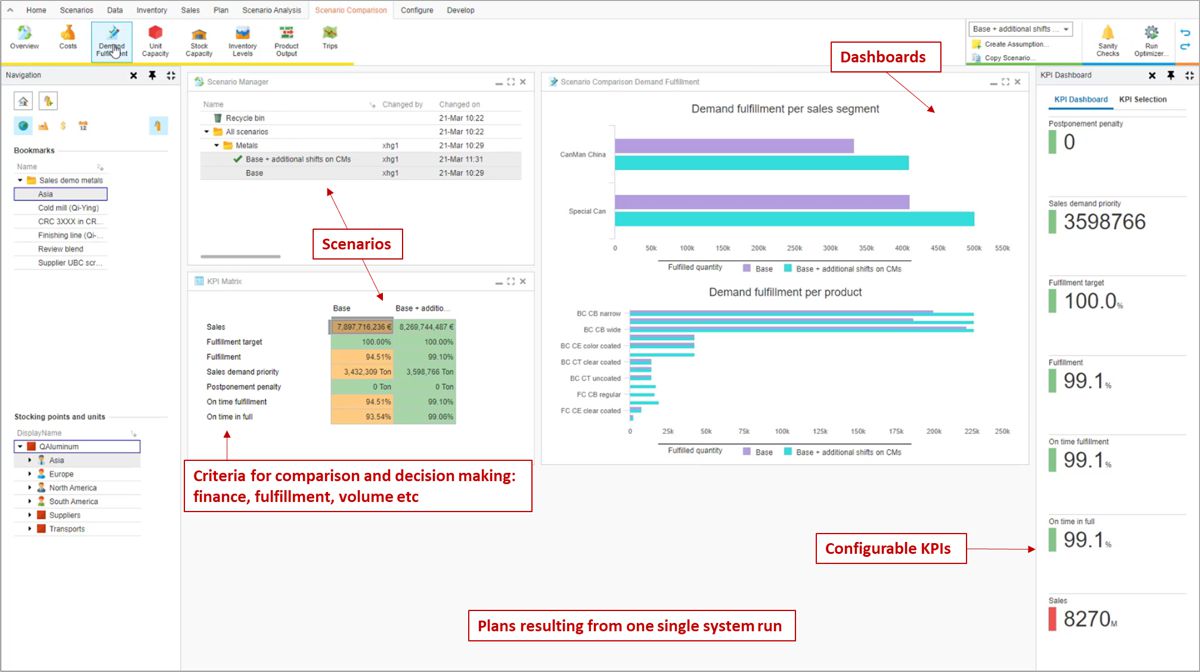Value Chain Planning and Decision Making in times of Disruption
During uncertain times, the ability to react and execute are imperative factors for practical results, due to the unpredictability of demand. Speed in decision-making is mandatory, while the need to adjust plans in the face of daily changes, or even to redesign the whole plan due to a new macro element, demands an agile process.
Today’s business climate has brought a new reality that expands the urgency and need for action plans. Planning teams play a critical role in the elaboration of contingency plans. These plans focus on scenarios in which the status, restrictions, conditions and demand are apt to change quickly.
We must work in cycles with a very high frequency where models like OODA loop (Observe, Orient, Decide, Act) within VUCA environments (Volatility, Uncertainty, Complexity, Ambiguity), originally arising within a military context, now become applicable to the business reality.
The OODA loop has a practical application in the corporate environment corresponding to an integrated, fast, and assertive mindset within high-demand and dynamic Sales & Operations Planning (S&OP). Following this process, the Sales & Operations Execution (S&OE) finds the operationalization of plans now within the internal environment, where the model finds synergy in the focus on operational excellence. See figure 1.

Considering the length of the chain and its impact on the overall picture, the importance of the integrated value chain in business decisions becomes increasingly important.
The Impact on Operations
It’s clear that decision-making depends on the existence of options and alternatives. The less information and insight about the possible impact in your operation, the more empirical and short-sighted the decision.
At the same time, the analysis can take a long time due to the disaggregation of information in different spreadsheets or systems. This process becomes difficult–if not impossible leading to decisions based on “rule of thumb.” See figure 2.

What is clear is that making plans and scenarios today is not something quick and simple. Years of investment in transactional, localized and execution-oriented business solutions left the planning part supported by archaic functions such as MRP, satellite systems and Excel spreadsheets.
All of these methods fail to provide the necessary visibility and agility for the necessary supply chain plans. The amount of time spent using these outdated tools is a barrier to the efficiency of planning teams and represents a risk to the quality of the company’s results when they are put into practice. This results in few viable alternatives for decision-making at planning meetings and a departmental view.
Quick planning in the assessment of scenarios that analyse all the important impacts within the chain, given the dynamics of new demands and restrictions each day, is possible only with systems that eliminate the need to calculate manually and in an integrated manner these points:
- How to distribute and supply, with how many resources, to which customers, at the most appropriate cost;
- The inventory level plan throughout the chain, for the defined policies and the service level and how it reacts in all considered scenarios;
- What is the best production mix taking into account the capacity, the availability of resources; which plant, line and resource will be used to produce which product over the planning horizon;
- The best financing plan with the corporation’s financial objective, profitability, margin and / or cost.
The ability to react and execute amidst the unpredictability of demand is vital. Speed in decision-making, the ability to adjust plans quickly—or even to design an entirely new plan—is critical when deadlines are pressing.
Now, we’ll look at the “analytical scenario exercise” and how decisions based on certain scenarios heavily impact each aspect of the value chain. In fact, the condition of each scenario is that it contains all the elements relative to planning.
In essence, this includes the entire chain of supply, production, storage, distribution and finally, the customer, so that the plans make sense, all involved parties. Ultimately, what KPIs, as metrics and indicators derived from the set of plans are taken into account and prepared for each scenario.
Technology for Effective Planning
For the decision-making process, the comparison of scenarios in an easy and objective way based on the indicators allows the choice based mainly on rationalized financial criteria. Figure 1 shows a dashboard that exemplifies this concept.
Working with Excel spreadsheets does not contribute the efficiency, speed and agility necessary for planning teams to bring the best plans to the company. On the contrary, it eliminates the possibility of creating integrated scenarios, excluding the possibility of the best choice.
The best decision here takes into account the most viable option among all possible options. Here, planning solutions with optimization fit very well with this concept. This includes the use of models that reflect the value chain—from raw material to delivery to the customer—with calculation support through optimization engines. This also considers elements of predictive and prescriptive analysis and in-memory processing.
More advanced S&OP systems have these characteristics, and the results and benefits of this new level of technological support meet the current corporate business needs:
- All-important plans (purchasing, production, storage, distribution, export, import, etc.) can be the result of a single round of the system.
- Trade-offs between plans in each area must be considered.
- KPIs guide planning objectives, especially financial ones.
- Simulations and scenarios can be created quickly and compared for impact analysis and decision making.
- The generated plans are optimized, and not just feasible or simply amenable to execution.
- Independence of spreadsheets to complement the plan.
- Speed of planning and revising according to market dynamics.
In today’s “new normal”, we will see the importance of the ability of companies to plan operations more efficiently and with the necessary accuracy to meet variable demands through processes where integration is essential to bridge the corporation’s strategic objectives. The execution of operations, balancing customer service, cost, risk and asset strategies are other critical elements to achieving objectives.
In this sense, advanced S&OP systems will be strong allies in post-crisis recovery, working with variable visibility as the recovery scenario advances over time, looking at the impacts of plans across the entire chain and allowing for better decision-making appropriate to each new scenario that appears.
Through fast, though not brash, actions and decision-making, businesses can utilise a range of analytical tools and insights to drive their business forward.
Value chain planning during disruptive times, simplified to its core, is the process of estimating external influences and providing the clearest, and best, navigational path. Without proper tools, this process can never reach its full potential.
This is often hidden by the mediocracy of spreadsheets and other lacklustre options. While they help to provide some form of reasoning for a decision, it’s rarely a truly informed decision that has taken into account all possible variables.
Article by Andre Miyajima, for 3DS DELMIA, part of the Dassault Systèmes Group.




















